Diodes are semiconductor devices. The term “semiconductor” means that the device conducts differently in different circumstances.
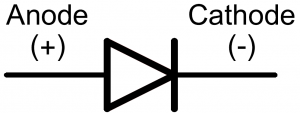
In the case of a diode, if the voltage across it from Anode to Cathode is too low or is negative, then it does not conduct current, or at least not much current. Once the voltage reaches a certain threshold, the diode “turns on”, and it conducts almost like a short circuit. When in the turned on state, voltage across the diode is pretty much decoupled from current flowing through it. That is, voltage stays close to the threshold voltage no matter how much current flows through.
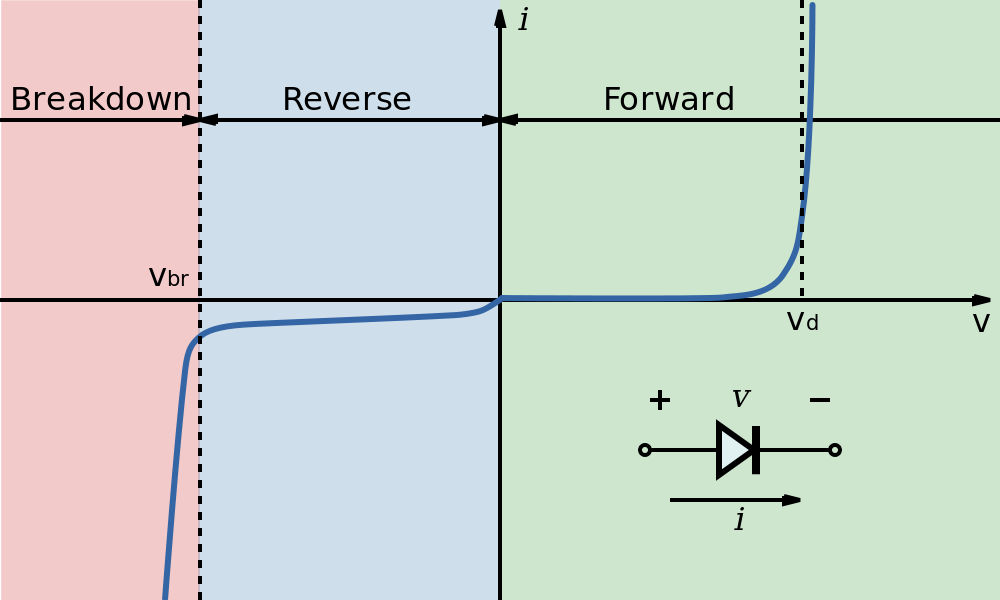
The picture above shows a graph of current versus voltage for a diode. In the middle where voltage is zero, current is also zero, and current stays at zero as voltage is increased until voltage nears the threshold (Vd) at which point current starts to flow and additional current does not change voltage much from Vd. Vd is also called the forward voltage Vf of the diode.
For negative voltage, meaning the anode is at lower voltage than the cathode, the diode enters the reverse region where a small amount of current leaks in the backwards direction (from cathode to anode). As the voltage becomes more negative, the diode reaches the reverse breakdown voltage threshold (Vbr). At Vbr current starts to flow freely and voltage stays pretty much at Vbr. For most diodes, operation in this breakdown region causes damage to the diode and must be avoided. The exception to this is a zener diode, which is intended to operate in this region.
Diode Symbols

Key Specifications of Diodes
- Forward voltage threshold (Vf) – the voltage threshold for the diode to turn on in the forward direction
- Reverse breakdown voltage (Vbr) – the negative (reverse) voltage threshold beyond which the diode enters the breakdown region.
- Maximum forward current – the maximum forward current that the diode can handle without getting too hot. The heating is caused by power dissipation, which is equal to voltage across the diode times current through the diode. P = V * I. Note that since this rating is due to heating, it is heavily dependent on how and where the diode is implemented (air flow, nearby hot devices, heatsink, etc.).
- Maximum reverse current – for zener diodes, the maximum reverse current it can handle before it gets too hot.
Types of Diodes
General Purpose Diode
- Vf is in the range of .6V to .7V.
- A wide variety of reverse breakdown voltage ratings are available.
- A wide variety of maximum forward current ratings are available.
- Available in surface mount and through-hole mounting styles.
- Often used as a barrier to prevent current flow in one direction
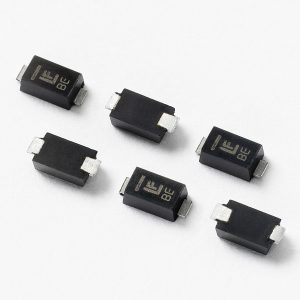
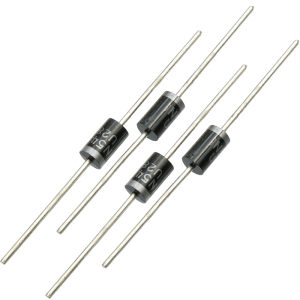
Schottky Diode
- Schottky diodes are similiar to general purpose diodes, except have lower forward voltage.
- Vf in the range of .15V to .45V.
- Switch from off to on more quickly than general purpose diodes.
- Often used as a clamp to keep the voltage of one signal within .45V of another (e.g. ESD clamp)
- Also, often used in power applications to minimize power dissipation due to the lower forward voltage. P = V * I.
Zener Diode
- Intended to be used in reverse breakdown mode. But also operates like a regular diode in the forward direction.
- Wide variety of Vbr values available. Anything from 2.4V up to 1 kV is available. Note that Vbr is also often called the Zener voltage.
Typically used to clamp the voltage of some signal line to a particular voltage. - Also, often used for ESD clamping, since they can clamp both positive and negative voltage spikes.
- Can be used to provide a steady voltage power supply. For example, if you only have 5V power available, and you have one chip that needs 3.3V, a zener may be a good way to go. But, this solution is quite inefficient, and the voltage will not be as steady as other solutions like a linear regulator, so this only works when the load doesn’t need much current and is not sensitive to supply voltage variation.
- Available in through-hole or surface mount forms and in same variety of package sizes as general purpose diodes.
Light Emitting Diode (LED)
- Like other diodes, LEDs dissipate power in the form of heat, but they also emit light.
- The wavelength of light emitted is typically in a narrow range meaning a narrow band of color is emitted. The color an LED emits depends on the material used to construct the LED and not all colors are available. Besides colors in the visible spectrum, LEDs are available in infra-red and unltra-violet. LEDs can also be encapsulated in colored material that can alter the color of light emitted.
- The forward voltage of LEDs varies quite a bit and is different for each color. Vf can be anywhere from 1V to 12V.
- When implementing an LED, you typically want to turn it on with a constant, deterministic current, because its luminescence is determined by the current flowing through it.
- Very efficient light sources. A small amount of power produces alot of light.
- Used for illumination, indication, and communication. By communication, I don’t mean for quickly transmitting large amounts of data such as can be done with a laser diode using fiber-optic cables. For example, an LED can be used to make an optical interrupter (optical switch) where you have an LED on one side of a slot and a phototransistor on the other side, and the light from the LED turns on the phototransistor if it gets through the slot, or the phototransistor is turned off when the slot is blocked.
- Available with multiple LEDs in one package. These can be different colors like green and red making a tri-color LED (red, green, and yellow if both are on).
- Often have lenses that focus or spread the viewing angle of the light.
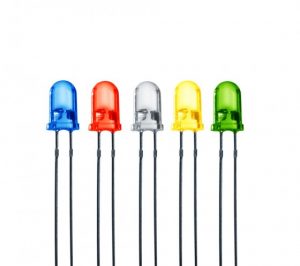
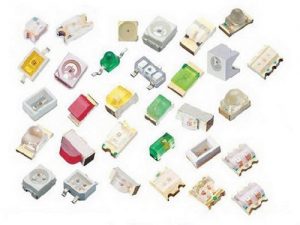
Laser Diodes
- Laser diodes emit laser light meaning light that is in a very narrow range of wavelength and is emitted in a very narrow directional spread.
- Used for fiber-optic communication, barcode reading, DVD reading and recording, laser printing, surgery, and more.
- Typically, you will not implement a discrete laser diode, but will buy an application specific module. For example, for fiber-optic communications you will buy the appropriate fiber-optic transceiver and implement that.
- By the way, fiber-optic communcations have some very nice features. Each side of a fiber-optic cable is electrically isolated from each other, and the optical signal going through the cable does not produce any electromagnetic interference (EMI) an is immune to EMI from other sources. And, the optical signal can be really, really high frequency, and can be transmitted really, really long distances. Implementing fiber-optic transceivers on a circuit board, though, is quite complex.
- Laser diodes have associated safety regulations and fall into different classes depending on the level or harm they can cause. Products containing lasers must have warning labels.
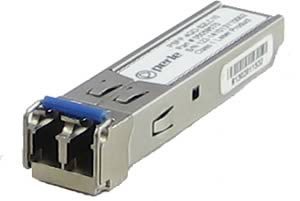
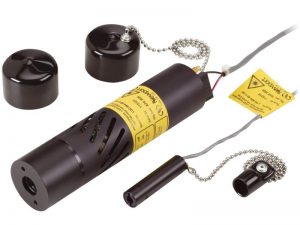
Power Diode
- Power diodes are designed to handle large currents and dissipate lots of heat.
- Used as rectifiers that convert alternating current (AC) to direct current (DC), used as catch diodes in DC:DC switch power converters, and used for reverse polarity power protection.
- High power versions of general purpose diodes, Schottky, and Zener are all available
- Schottky diodes are often used in power applications, because the lower Vf leads to lower power dissipation, which yields better efficiency and less heat.
- Due to the large current specs, Vf ratings are higher for power versions of diodes, and it is important to take this into account. P = V * I.
- Some through-hole power diodes are designed to allow attachment of a heat sink, and some surface mount power diodes are designed with a thermal slug (large metal surface) that can be connected with multiple vias to the ground plane of the circuit board to spread the heat.
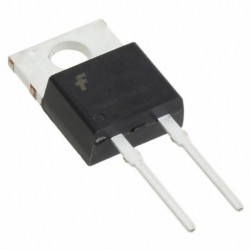
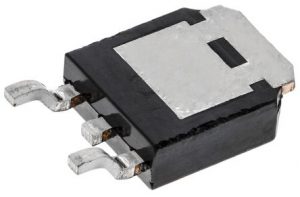
Here is a video about diodes from The Organic Chemistry Tutor on Youtube.
Next: Transistors
